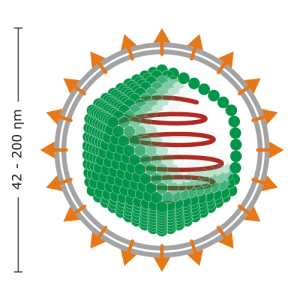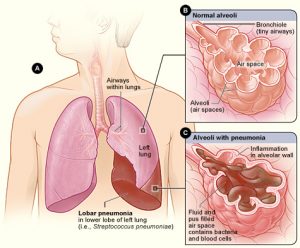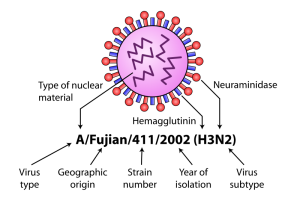By Christina Marvin
If you have not come down with the flu yourself, you most likely have had a friend or family member who has. It rears its ugly head each year, infecting those it comes in contact with and discriminating against no one. If you’ve been following this blog, you may have read about the infamous rhinovirus, a.k.a. the common cold. Now it’s time to learn about a different viral culprit: influenza, also known as the flu.

Influenza, more commonly known as the flu, is a virus. A virus is an infectious agent made of genetic material surrounded by a tough protein coat. Even though viruses have been studied for years, scientists still debate whether they are “living” organisms or not. To be classified as “alive” an organism needs to replicate. Viruses can replicate…but only inside other organisms like ourselves!
The flu travels between people to replicate through easy access points such as your eyes, nose, or mouth. Once it gets cozy, the virus hijacks your cell’s normal machinery to make millions of copies of itself! It’s easy to think that these nasty virus copies are the main cause of your illness. While the virus itself does play a small role, that’s not the full story. In reality, doctors describe the 2 main causes of severe flu symptoms and deaths, both of which are complications from the flu, not the flu itself. Specifically, they point to secondary bacterial infections and your body’s own overactive immune response to viral replication.

Bacteria, unlike viruses, are living microorganisms. They are made up of one cell and can replicate on their own. So how do so many people catch a bacterial infection on top of a viral one? Often times, the flu does enough damage in the lungs during its replication cycle that it causes major inflammation, making it easier for bacteria to invade. It doesn’t take much for lung infections to develop into full blown pneumonia, which is a leading cause of flu deaths. Children under 5 and the elderly are particularly at risk because their underdeveloped or weakened immune systems already make them easy targets for opportunistic bacteria.
The second most common way that the flu can ultimately lead to death is in through your body’s own overactive response to the virus, also called sepsis. In your body’s defense, it is trying to protect you. In some cases, however, the response is too strong and our bodies fall victim to their own fierce defense systems, often through organ failure. Unlike bacterial infections, otherwise healthy people are at a higher risk for sepsis complications because of the hardiness of their immune systems.

Why is the flu so prevalent and deadly this year? One reason has to do with the type of flu, or strain. Scientists have identified 4 types of influenza virus: A, B, C, and D. Only Influenza A and B have caused epidemics and Influenza A is most common during flu seasons. Influenza C is less common and causes milder disease while Influenza D has yet to be found in humans. Although full virus names can be very long, people tend to refer to them by their subtype determined by surface proteins HA (hemaglutinin) and NA (nueroaminidase). This year, influenza A H3N2 is the main culprit. This specific virus with these specific proteins is particularly severe and tends to cause more serious complications in all age groups, but especially children and older adults, and may even decrease the effectiveness of the flu vaccine. A large field of science involves development of new kinds of vaccines to combat growing resistance.

How can you protect yourself and others from the flu? The CDC recommends that to reduce flu transmission, you should get the annual flu vaccine. Stay home if you are sick. You can also guard against the flu by washing your hands frequently, covering your mouth when you cough or sneeze, and wiping down areas that may have been contaminated with flu germs. Follow these steps, and you will have a better chance of evading the nasty flu this season.
Edited by Sam Stadmiller and Anna Chiarella
